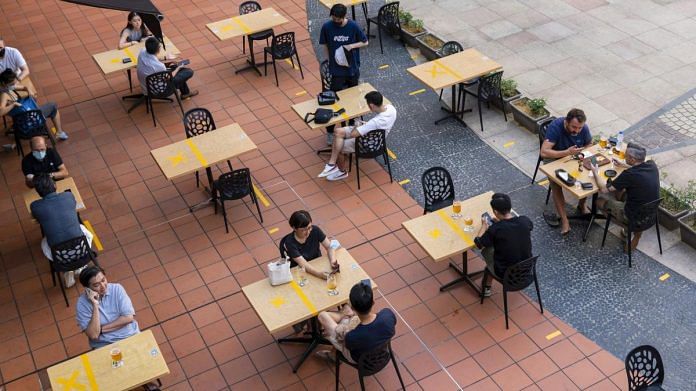Singapore says it wants to back away from strict rules to combat Covid-19 and the curbs on commercial and social life that come with them. The reality on the ground shows a lack of conviction.
Singapore returned to a lockdown-like state in mid-May as the number of unlinked infections started rising — a troubling development for a population that largely hadn’t been vaccinated. While the measure was a blow for the city-state, where cases had hovered near zero for months, the situation has improved fairly quickly. Step by step, those restrictions are now being lifted and shots are progressing. Schools will resume in-person after the summer break, while larger social gatherings and dining in are permitted again.
Drill deeper into this encouraging overall picture, though, and details suggest a country ambivalent about where, and how far, to go from here. Singapore looks and feels like a place that wants the outward signs of being open for business, but appears unwilling to take many risks to get there. Showcase events have been shelved. An air-travel bubble with Hong Kong — critical for a government-backed airline with zero domestic routes — has gone nowhere. Offices that were only just beginning to repopulate were told to empty. Even buying milkshakes for my two small kids at the mall dissolved into paperwork and bureaucracy.
School holidays last week gave me a decent vantage point to observe Singapore’s latest attempt at reopening. Hush-Hush Hannah, a cartoon character plastered to subway windows, was there to watch over me as I traveled. Her job is to remind passengers to keep the volume down. While Hannah began riding the Mass Rapid Transit network before the pandemic, her skills are as relevant today as ever. Hannah’s speech bubbles reinforce the signboards at station entrances instructing commuters to avoid talking to prevent the spread of droplets. At busy junctions, such as Serangoon in the center of the country, an attendant marches into the carriage waving a placard urging silence.
Dining also has evidence of stop-start progress. At Tanjong Beach Club on the islet of Sentosa, servers were briskly delivering ice-cold buckets of beer and platters of fries. But something was missing: tunes. Recorded music is now forbidden, lest people talk too loudly over the noise and transmit germs. (As I munched my burger, I wondered if the beat ban would become as iconic as a chewing-gum prohibition imposed decades ago. I still encounter people who know little more about Singapore than the gum rule.)
These experiences illustrate the split-screen life in Singapore. Politicians now talk about Covid as endemic, something that vaccinated people can tolerate without falling very ill. Officials have begun likening the disease to the flu and have held out the prospect of removing masks outdoors and a revival of the travel industry. Yet after more than a year of on-again, off-again crackdowns, it’s hard to see Singapore dispensing with the extreme risk aversion that’s defined its response to the pandemic.
The approach has delivered results some would envy. Deaths have been few and far between, hospitals are coping, DIY test kits are available at pharmacies and leaders hope to have two-thirds of the country’s 5.7 million people fully inoculated by early August.
Across the bridge in Malaysia, hospitals are overflowing, daily infections are in the thousands and the economy remains in the grip of recession. In Indonesia, a short ferry ride away, less than 10% of the far greater population is vaccinated. A spike in illness has made the sprawling archipelago the latest Covid hotpot in the region.
Still, the lack of specifics about how substantially life will change after Singapore’s vaccination push is surprising, particularly given its instinct for over-planning. Officials have floated the idea that inoculated people will have more scope to move, attend events and travel. How much more? To where will they be allowed to go, for business or pleasure, and under what kind of closely managed itinerary and quarantine? What will happen to the offices in gleaming towers sporting logos of world financial giants? This week, United Airlines Holdings Inc. placed the biggest jetliner order in company history, a major vote of confidence in a post-Covid world. The message at Singapore Airlines Ltd. is decidedly more circumspect.
There is a risk that Singapore imprisons itself in this relative success. For now, the price of hesitation isn’t prohibitive. The economy is expected to grow as much as 6% this year, according to the government, lifted by a powerful revival in the U.S. and China. All the country needs to do is step out of the way. When the pace of recovery slows next year, the moves will have to be a lot bolder. –Bloomberg
Also read: How to reopen without risk? That’s the big question for Singapore






